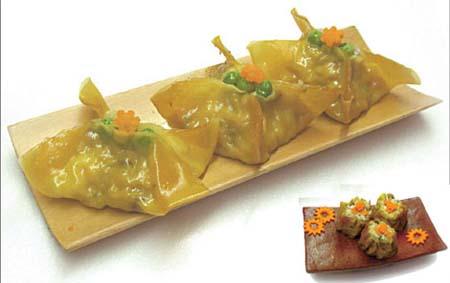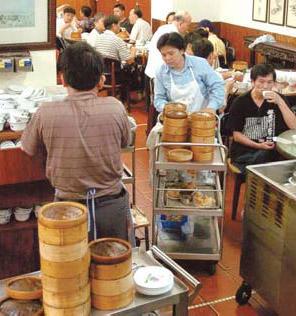Food that "touches the heart"
2010-03-23 09:34 BJT
Drinking tea and eating little snacks called dim-sum is a way of life for Cantonese.
 |
| Patrons to a yum-cha restaurant in Hong Kong browse through the newspaper while waiting for their dim-sum. |
In Chinatowns all over the world, there is inevitably a yum-cha restaurant, an exact replica of those common in Guangzhou or Hong Kong. Perhaps it is a little bit of home in a strange country to many Chinese immigrants, and it's often where they congregate and exchange news from town or village.
Busy waiters with white towels flung over their shoulders weave among the crowded tables, kettle in hand, ready to fill up the diners' teapots with hot water.
Ladies with stainless steel push carts add to the din as they call out their wares, kept piping hot in double-decker bamboo baskets on the steamers.
Prawn dumplings wrapped in snowy-white translucent skins, pork dumplings topped with a smidgen of crab roe, crisp fried wantons decorated with drizzles of sweet-sour sauce, soft white buns hiding a sweet and salty filling of barbecued pork - these are only the basic offerings in a dim-sum restaurant.
More exotic platters may include salt-and-pepper squid tentacles, chicken feet braised in a black bean and garlic sauce, and pork ribs steamed with salty plums and chili.
There are also the dishes that are served up by the table like the salted pork and century egg congee, or the radish cake that is fried with each order and served straight from the frying pan with a saucer of chili sauce.
 |
| Ladies with stainless steel push carts add to the din as they call out their wares, kept piping hot in double-decker bamboo baskets on the steamers. |
While the younger diners crane their necks waiting for the next cart and its goodies, more sedate older members of the family will pour tea for each other and enjoy their little cups of the fragrant beverage. The more dedicated drinkers may even bring along their personal urn of tea leaves.

 Mail
Mail Share
Share Print
Print


 Video
Video









 2009 China Central Television. All Rights Reserved
2009 China Central Television. All Rights Reserved